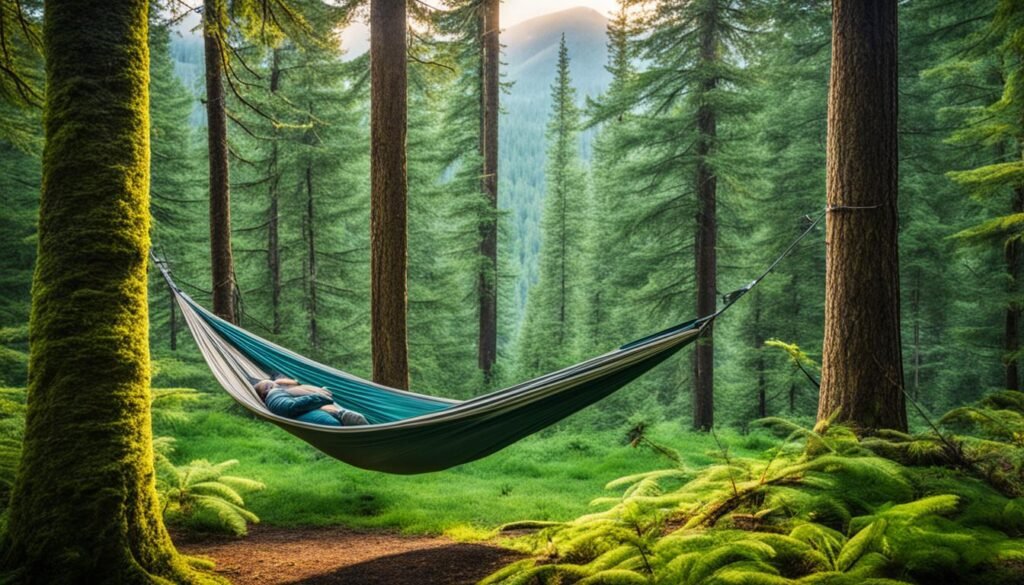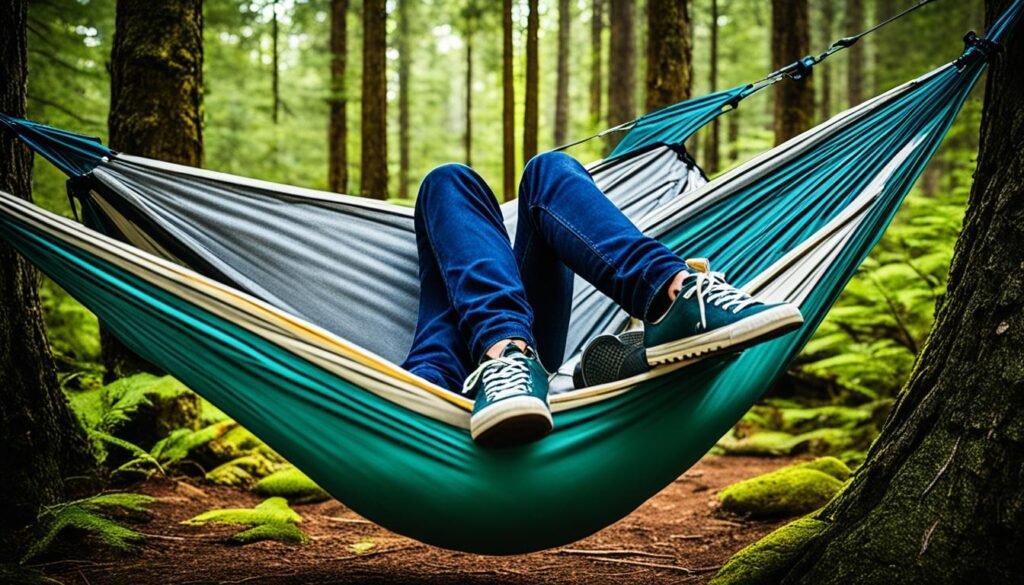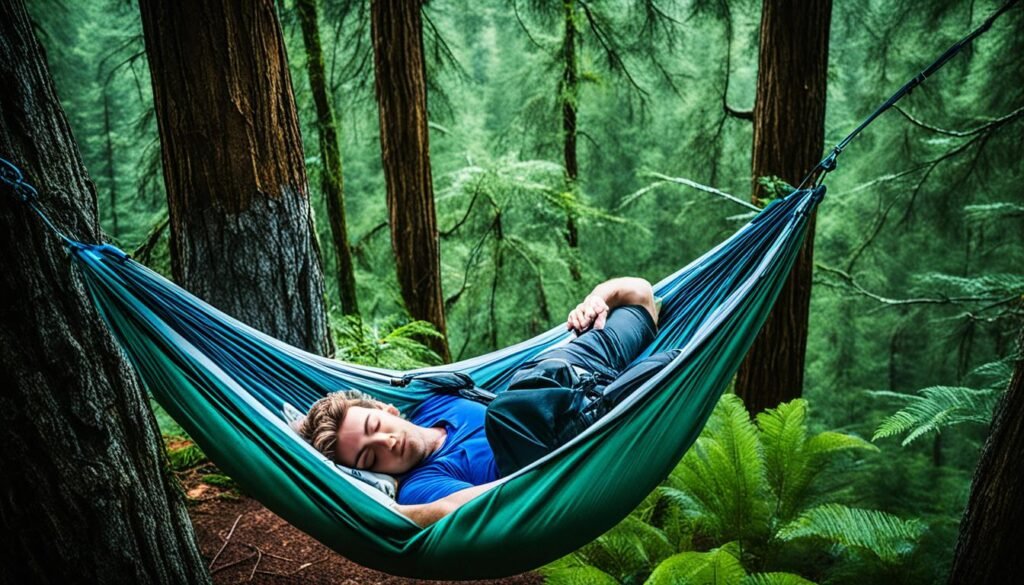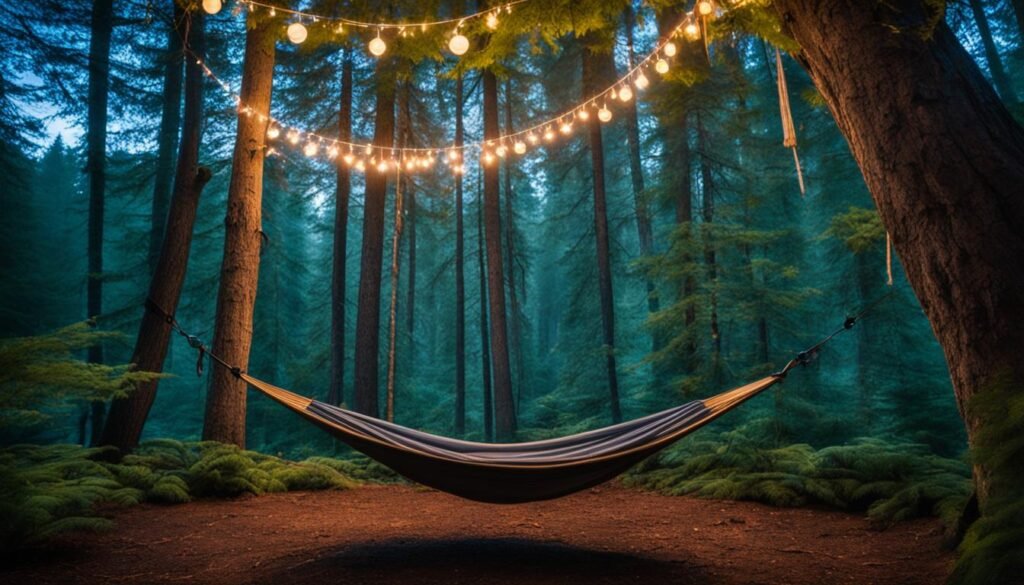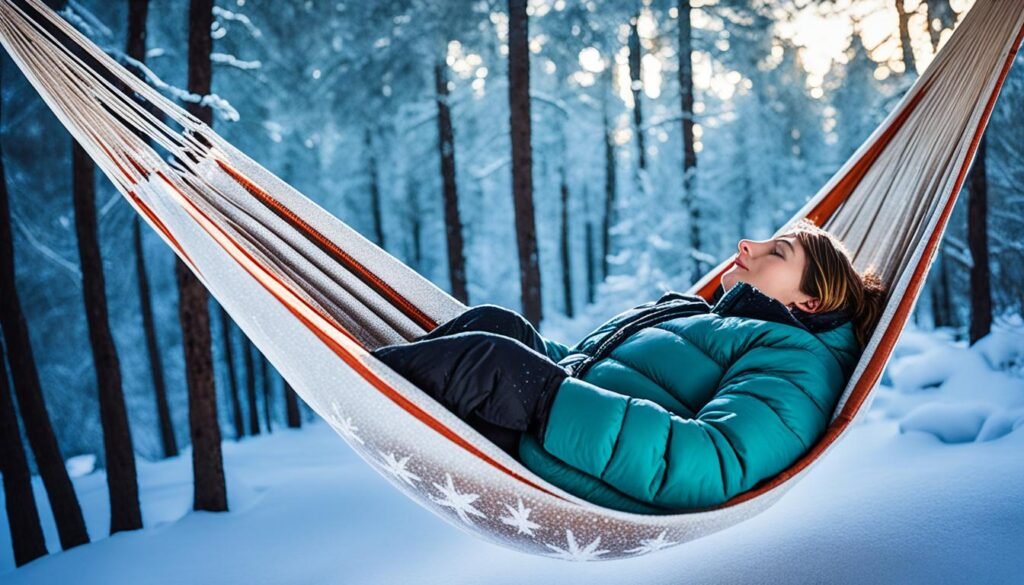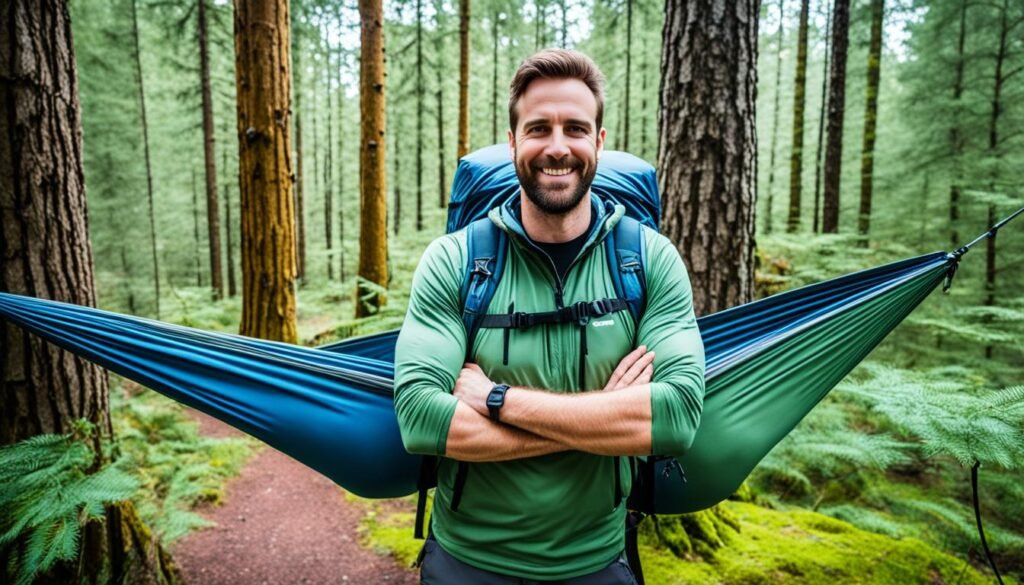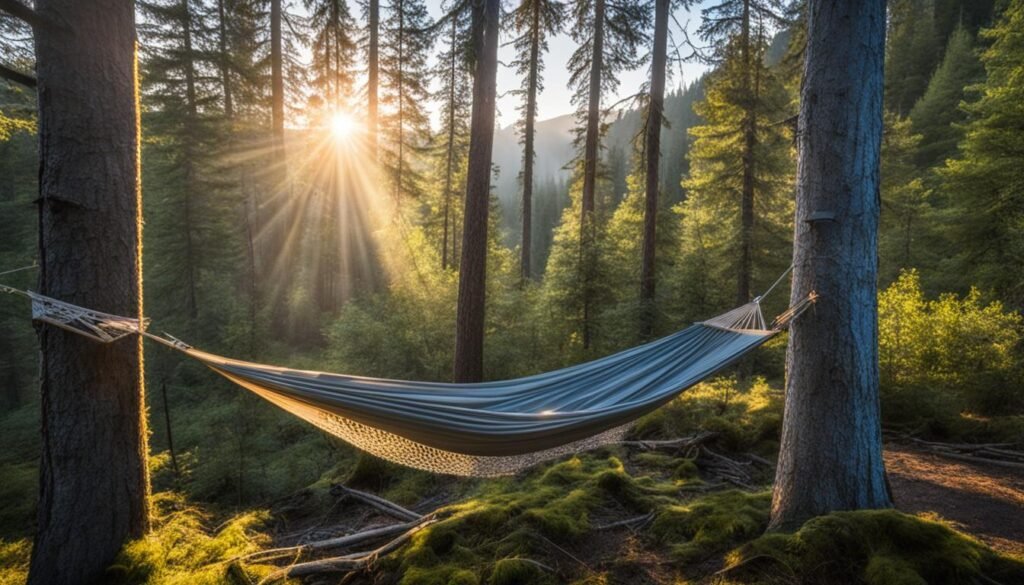Hammock camping is a fun and comfy way to camp differently from using tents. But, it has its ups and downs. Let’s look at the good and bad of hammock camping.
Key Takeaways:
- Hammock camping provides a comfortable and versatile outdoor experience.
- Advantages include modularity, usability in various terrains, and enhanced sleep quality.
- Drawbacks include limitations in capacity and potential challenges in finding suitable campsite locations.
- Consider personal preferences, trip requirements, and available resources when deciding to hammock camp.
- Proper planning and consideration can ensure an enjoyable and refreshing hammock camping trip.
The Gear for Hammock Camping
When you go hammock camping, you need the right gear. This makes your outdoor time fun and comfy. Let’s discuss what you should look out for:
The Hammock
The hammock is key for camping. Choose one that’s durable and light. It should fit you well and hold your weight.
Hanging Straps
You’ll use hanging straps to tie the hammock to trees. Pick straps that are strong and easy to adjust. They must support your weight well.
Bug Net
A bug net isn’t a must, but it’s very useful. It keeps mosquitoes and bugs away. This lets you sleep without being bothered.
Tarp
Consider getting a tarp. It’s great for keeping rain and bad weather away. There are different kinds, like flat or hex tarps, for coverage.
Underquilt
Staying warm is important. The air below can get cold. An underquilt goes under the hammock for warmth on cold nights.
Top Quilt
A top quilt is like a sleeping bag. It keeps you warm above. It’s easy to adjust for the most comfort.
Pillow and Ridgeline Organizer
A pillow makes sleeping nicer. A ridgeline organizer keeps things like phones close. It hangs on the hammock’s ridgeline.
Pros of Hammock Camping
Hammock camping has many benefits for those who love the outdoors. First, hammocks let you pick what you need for your trip. They are easy to carry and break down into parts. Also, if you have a hammock, you don’t need a separate chair for your backpack.
Using a hammock with a tarp gives you more space. This area is great for cooking, keeping things, and just relaxing. Hammocks let you camp in many places. You don’t need flat ground. This lets campers enjoy different types of land, like rocky or sloped places.
Sleeping in a hammock is very comfortable for many. Lying diagonally gives a cozy feeling and supports the back well. This might help you sleep better, especially if you have back or joint pain. Hammocks fit the shape of your body. This reduces pressure areas and makes sleeping more comfy.
“Hammock camping offers modular customization, convenience, and enhanced comfort, making it a popular choice among outdoor enthusiasts.” – Amanda Thompson, Experienced Camper
Advantages of Hammock Camping:
- Modularity and customization
- Easy packing and separation into components
- Elimination of the need for a separate backpacking chair
- Creation of a dedicated space for cooking, storage, and relaxation
- Flexibility in choosing a campsite
- Ability to hang in various locations and on uneven terrain
- Enhanced comfort and better back support
Hammock camping has a lot to offer. It is very adaptable to different kinds of camping. And it makes camping more comfortable. But, it’s important to think about both the good and bad sides. This helps decide if hammock camping is right for you.

| Advantages of Hammock Camping | Benefits |
|---|---|
| Modularity and customization | Allows campers to choose components based on their specific needs |
| Easy packing and separation into components | Makes transporting the gear more convenient |
| Elimination of the need for a separate backpacking chair | Reduces the amount of gear needed |
| Creation of a dedicated space for cooking, storage, and relaxation | Enhances organization and comfort at the campsite |
| Flexibility in choosing a campsite | Allows for camping in various terrains and landscapes |
| Enhanced comfort and better back support | Improves sleep quality and reduces pressure points |
Cons of Hammock Camping
While hammock camping has its perks, it’s important to look at the cons too. Disadvantages of hammock camping might affect your trip. So, it’s good to think about these before choosing to camp with a hammock.
1. Limited Space for Multiple Sleepers
Hammock camping often means less room for more than one person. If you’re not alone, or don’t have a big hammock, it can be tough. This makes it hard for those camping with others or in groups.
2. Dependence on Tree Availability
To set up a hammock, you need trees or strong supports. Not all places have these, like deserts or open fields. So, finding a spot for your hammock can be hard in these areas. This limits where you can camp with a hammock.
3. Slightly Heavier Than Tarp-Style Tents
Compared to tarp tents, hammocks can be a bit heavier. They don’t need poles, but with the straps and extras, they weigh more. If you like to pack light, the extra weight is something to think about.
4. Insulation Requirements in Colder Temperatures
In cooler weather, hammocks can be less warm than tents on the ground. They hang in air and don’t have ground insulation. To stay warm, you need extra gear like an underquilt under the hammock. This can be extra hassle and cost.
“Hammock camping is flexible and cozy but it’s smart to know its drawbacks of hammock camping. Think about space for everyone, finding trees, the weight, and staying warm in the cold. These are important when picking how to camp.”
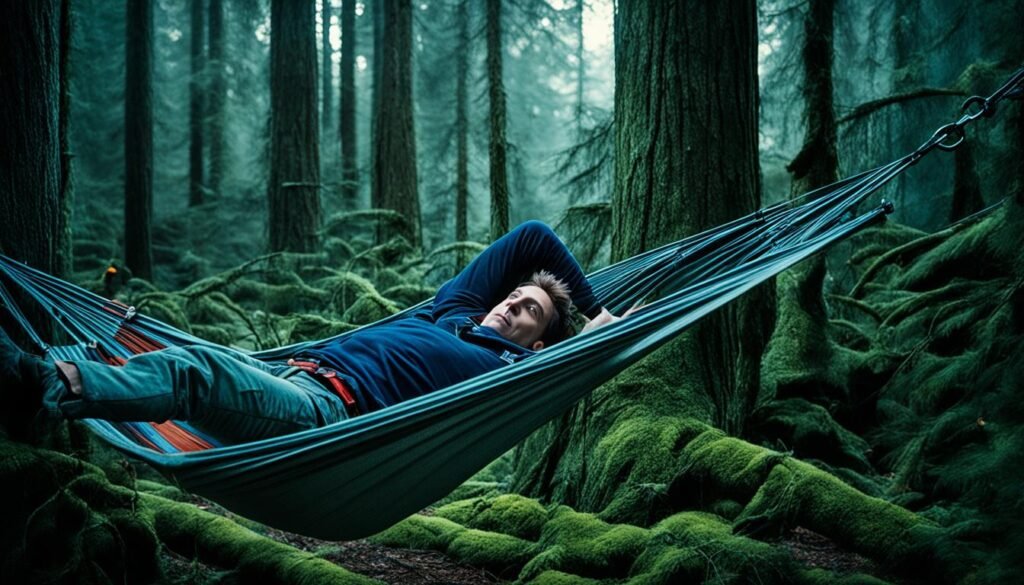
Knowing the disadvantages of hammock camping helps you choose wisely and plan. Even with these issues, many campers feel the good parts of hammock camping are worth it. It stays a favored way to enjoy the outdoors.
Lightweight and Easy Set-Up of Hammock Camping
Hammocks are lighter than tents. They only need straps and the hammock itself. This makes them great for backpackers wanting to carry less.
Setting up a hammock is also simple. Find two trees, attach the straps, and your hammock is ready. This is much easier than setting up a tent.
Hammocks make camping simple and efficient. They have fewer parts than tents. So, setting up is quick and easy. Campers get to enjoy nature more.
The Benefits of Lightweight Hammock Camping
For lightweight backpacking, hammocks are key. They weigh less, so hiking is easier. You can go farther and explore more.
Hammocks also take up less space. This leaves room for other important items. They are perfect for those who like to travel light.
Despite being light, hammocks are strong. Made from durable materials, they last long. They offer a secure place to sleep.
Easy Set-Up for a Stress-Free Camping Experience
Setting up a hammock is quick. With the proper gear, you can easily make a comfy sleeping spot. It saves time and energy.
To start, find two good trees. Wrap the straps around them. Then, attach the hammock, adjust, and relax. It’s that easy.
Hammocks let you camp almost anywhere. They work over rocky or uneven ground. This means you can camp in unique places.
Lightweight hammock camping is all about simplicity and joy. It lightens your load. Plus, it makes your outdoor adventure easier and more fun. Whether it’s for many days or just a weekend, it lets you deeply connect with nature.

| Comparison | Hammock Camping | Traditional Tent Camping |
|---|---|---|
| Weight | Lightweight; requires suspension straps and hammock | Heavier; involves tent poles, stakes, and rainfly |
| Set-Up Time | Quick and easy; a few minutes to hang the hammock | Time-consuming; assembling tent poles and pounding stakes |
| Packability | Compact; takes up minimal space in backpack | Bulkier; requires more room in backpack |
| Versatility | Can be hung above uneven terrain and rocks | Requires flat and level ground |
| Comfort | Provides ergonomic support and a gentle rocking motion | Relies on sleeping pads for cushioning and insulation |
Versatility and Comfort of Hammock Camping
Hammock camping is unique. It’s not like tent camping that needs flat ground. You can hang hammocks on slopes or rocky areas. This lets campers sleep comfortably without worrying about the ground. It opens up new places for adventures.
Hammocks are super comfortable too. They support your body well. You can sleep on your back or your side easily. Finding a comfy sleeping position is easy in a hammock.
Hammocks aren’t just for sleeping. They can be cozy chairs during the day. You can sway gently, read, or enjoy nature. It’s a great way to relax and feel at peace.

Hammock camping is all about comfort and versatility. It works well in different places and offers great sleep. It’s perfect for anyone who loves being outdoors.
Protection and Convenience of Hammock Camping
Hammock camping offers both protection and convenience in various camping scenarios. It protects campers from wet weather. With a rainfly, it creates a dry, sheltered place to sleep during rainstorms. So, you won’t wake up in a puddle anymore.
The convenience of hammock camping comes from its easy setup. You can set up hammocks near water sources without clearing debris first. This means you can quickly relax and enjoy the peace around you.
“Hammocks are not only a comfortable way to sleep, but they also offer an excellent camping experience with added convenience. No need to worry about finding a flat, dry patch of land—simply find a couple of trees, hang your hammock, and enjoy nature’s cradle.” – Expert Hammock Camper
Also, hammocks help in leaving no trace. They have little impact on the ground, so plants aren’t harmed. This way, campers can explore without disturbing nature.
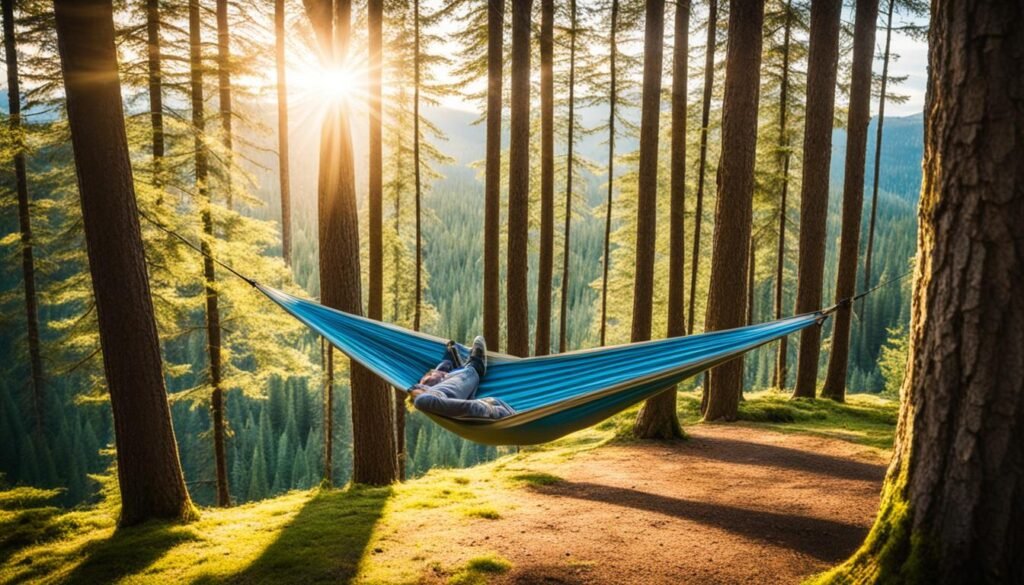
The Benefits of Hammock Camping
Let’s look at the benefits of hammock camping:
- Staying dry in wet conditions
- Quick and efficient setup
- Minimal impact on the environment
| Protection | Convenience |
|---|---|
| Provides shelter from rain | Easy setup near water sources |
| Keeps campers dry during storms | No need to clear the campsite |
| Minimizes the impact on the ground | Leaves no trace |
Considerations for Hammock Camping
When planning a hammock camping trip, think about a few key points. These tips will help make sure you have fun and stay safe outdoors. Let’s go over what these are:
Suitability for Group Size
Hammock camping works best for one person or a few people. Big groups might not find enough trees for everyone’s hammocks. So, think about how many people are going before choosing hammock camping.
Age and Mobility
Some people might find using a hammock hard. This is true for those who aren’t very mobile or older campers. If your group includes anyone like this, consider if hammocks are right.
Availability of Suitable Campsite Locations
Make sure there are enough trees for your hammocks at the campsite. Hammocks need strong trees or supports. It’s important to check this before picking a place to camp.
Privacy and Proximity to Nature
Hammocks let you get close to nature. But they might offer less privacy than tents.
Think about how much privacy you want. Then decide what’s best for you. Keeping these tips in mind will help you choose wisely for hammock camping.
Tips for Choosing the Right Hammock
Picking the right hammock can make your camping trip great. Here are some tips to help:
Opt for Camping-Specific Hammocks
Go for hammocks made for camping. They are tough and light, making them perfect for outdoor sleep.
Consider the Size
Make sure the hammock fits the number of people who will use it. There are many sizes available. Choose wisely based on how many will sleep in it.
Adjustable Suspension Straps and Bug Net
Choose hammocks with adjustable straps. They make setting up easy. Also, a bug net is great in buggy places.
Weight and Packability
If carrying less weight is vital, pick a light hammock. Look for ones that pack small, too. This is key for backpacking trips.
Following these tips will help you find a hammock that fits your needs. And ensure a comfy and fun experience.
| Consideration | Description |
|---|---|
| Suitability for Group Size | Hammock camping is best suited for solo campers or small groups due to limited hanging options. |
| Age and Mobility | Consider the age and mobility of campers, as some may find it challenging to get in and out of a hammock. |
| Availability of Suitable Campsite Locations | Ensure the chosen camping location has sufficient trees or supports available for hanging hammocks. |
| Privacy and Proximity to Nature | Determine your preference for privacy and how close you want to be to nature when choosing hammock camping. |
Hammock Camping Tips and Considerations
- Consider the suitability of hammock camping based on the size of your camping group.
- Take into account the age and mobility of campers when deciding on hammock camping.
- Ensure the camping location has suitable trees or supports for hanging hammocks.
- Consider the level of privacy and immersion in nature when choosing hammock camping.
- Choose a camping-specific hammock made of durable and lightweight materials.
- Select a hammock size that accommodates the number of campers.
- Look for adjustable suspension straps and consider adding a bug net for added convenience.
- Consider the weight and packability of the hammock for easier portability.
Tips for Choosing the Right Hammock
Choosing the perfect hammock for camping needs thought. Consider durability, size, accessories, and how easy it is to carry. Doing this, you get a hammock that fits your outdoor activities well.
Durable Materials for Camping Hammocks
Choosing a hammock that is specifically designed for camping is essential for durability and longevity. Look for options in nylon or polyester. These fabrics are strong and resist wear and tear well. They’re light, dry fast, and let air through. This is great for outside. Avoid cotton hammocks. They’re not as tough and get heavy and wet easily.
Consider the Size of the Hammock
When selecting a hammock, it’s crucial to choose the right size to accommodate the intended number of campers. Hammocks vary in size. Check their length and width before buying. Think about your height and body shape too. A larger hammock means more room to stretch but is harder to carry. For camping with a buddy, pick hammocks made for two.
Adjustable Suspension Straps and Bug Nets
Opt for hammocks that come with adjustable suspension straps for easy setup and versatility. These straps make hanging the hammock quick and stable. They work between trees or other spots. They fit different spaces. Also, think about if you need a bug net. It keeps insects away. This lets you sleep without bug worries.
Packability and Weight
For campers who prioritize lightweight and portable gear, pay close attention to the weight and packability of the hammock. Choose hammocks made for travel. They use light materials and are easy to carry. Hammocks with compression sacks take up less space in your bag. Check the hammock’s weight limit to make sure it can hold you safely.
Keep these points in mind to find a hammock that suits your camping style. It’ll make your time outdoors comfy and fun. A good hammock is key for a great backpacking trip or a calm night outside.
Hammock Camping in Specific Environments
Hammock camping is fun in many places, but different areas need certain checks. Whether it’s rocky lands, woods, or dry areas, knowing each spot is key. This ensures a good hammock camping trip.
Rocky and Steep Areas
In rocky terrains, hammocks are better than tents. Trees make great supports for your hammock. This lets you sleep well on rough ground. The hammock’s swing is also calming, making sleep sweet amid tough spots.
Heavily Wooded Areas
Hammocks are great in forests. They let campers pick sites with rough ground or thick plants. By hanging your hammock from trees, you sleep off the ground. Just make sure the trees can hold your weight well.
Arid or Barren Environments
It’s hard to find trees in dry or empty places. Little plants and few trees mean you must plan your camp spot well. You might need to use stands for hammocks or camp by rocks here.
To make hammock camping better in these areas, try these tips:
- Study the area’s ground and plants to check if it’s good for hammocks.
- Have other ways to hang hammocks, like stands or rocks, if trees are few.
- Pick a hammock with straps you can adjust for different tree spaces.
- Take straps that are kind to trees to lessen harm to the place.
By fitting your hammock to each place, you can enjoy its beauty and comfort. From forests to dry lands, hammock camping shows nature’s charm well.
| Environment | Hammock Camping Considerations |
|---|---|
| Rocky and Steep Areas | Hang hammocks from sturdy trees for a comfortable sleeping surface on uneven terrain. |
| Heavily Wooded Areas | Utilize hammocks to access campsites with uneven ground or dense vegetation, choosing healthy trees as supports. |
| Arid or Barren Environments | Research and plan campsite locations carefully, considering alternative hanging options if trees are scarce. |
Exploring different landscapes and tweaking your hammock setup lets you enjoy nature’s beauty. Hammocks give comfort and freedom across various settings.
Conclusion
Hammock camping is a cozy and flexible option. It beats traditional tent camping. It gives many perks to improve the outdoors.
With hammocks, you can adjust your gear for each trip. They work on uneven and rocky places. So, you can camp in more spots. Plus, hammocks make sleeping better. They support your back and feel like a cocoon.
But, hammock camping has some downs. It’s hard with big groups or partners. You need trees or strong supports to hang them. Also, in cold, you might need extra warmth.
In the end, choosing to hammock camp depends on you. Think about what you need and what you have. With the right prep, hammock camping is fun and refreshing. It’s great for those who love setting up quickly and sleeping well. Hammocks invite you to enjoy nature closely.
FAQ
What are the pros and cons of hammock camping?
Hammock camping is a fun, different way to camp. But it has good and bad points. Let’s look at them.
What gear do I need for hammock camping?
For hammock camping, you’ll need a few key items. These are the hammock, straps, a bug net, and a tarp. You also need an underquilt, a top quilt, a pillow, and something to organize your stuff.
What are the advantages of hammock camping?
Hammock camping has many benefits. It’s modular, easy to pack, offers more space, and lets you choose many campsites. Plus, it’s comfy and supports your back well.
Are there any drawbacks to hammock camping?
Yes, there are some downsides. There’s a limit on how many can sleep. You need the right trees to hang it. Also, it might weigh more than tent camping. And you need extra warm stuff in cold weather.
Why is hammock camping lightweight and easy to set up?
Hammock camping is light because you just need the hammock and straps. No need for heavy tent poles. Also, setting it up is quick and simple. It only takes a few minutes.
How is hammock camping versatile and comfortable?
Hammock camping is flexible because you can hang it over rough ground. And it’s comfy because it lets you lie in different ways. Plus, it can be a cozy chair during the day.
What are the protection and convenience aspects of hammock camping?
Hammocks protect by keeping you dry when it rains. They are also easy to set up by water. And, they don’t hurt the ground much.
What factors should be considered for hammock camping?
Think about if it’s just you or if you have friends along. Make sure there are good trees. Consider how easy it is for you to move. And think about how close you want to be to nature.
Do you have any tips for choosing the right hammock?
Pick a hammock made for camping. Make sure it’s big enough. Look for straps you can adjust and a bug net. Also, check how much it weighs and how small it packs.
Are there any specific considerations for hammock camping in different environments?
Yes. Hammocks are great in rocky or steep places. They work well in woods, giving more spots to camp. Yet, in dry or treeless areas, it can be hard to find a place to hang them.
What are the final thoughts on hammock camping?
Hammock camping is a comfy, different choice. Weigh the good against the bad. Make sure you have what you need. Think about where you’re going. With some planning, hammock camping can be great fun.

